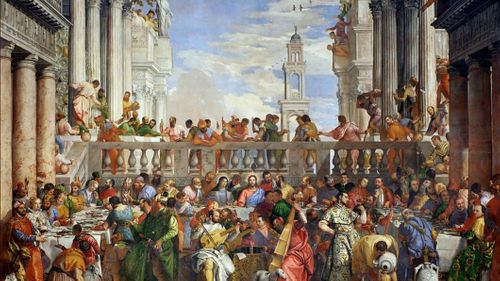A Crash Course in Paolo Veronese & the Hidden Meaning in his Artwork
Mar 20, 2024 · 2 mins read
0
Share

Paolo Veronese (1528 - 1588), a rockstar of 16th century Venice, painted vibrant scenes of life. Yet he loved to sneak in symbolism, often hidden in plain sight. Take 'The Feast in the House of Levi' - a biblical party scene turned commentary on clerical corruption.
Save
Share
First up, the banquet table doesn't seem right. Instead of a humble setting for Jesus's last supper, Veronese paints a gluttonous feast with a plethora of meats and delectable desserts. Was this his way of criticizing the Church's extravagance?
Save
Share
Notice the characters too; a fool, a dwarf, a parrot, dogs. No place for such 'lowly' creatures at a holy feast, yet there they are, mocking the sanctity. Subtle digs at the Church's hypocrisy?
Save
Share
Next, we have 'The Drunkenness of Noah'. A story of human weakness is now a metaphor for Venice's own indulgence and moral decay. Noah lies drunk, exposed - was this Veronese's wake-up call to his city?
Save
Share
Now consider 'The Martyrdom of St. Justina'. Instead of focusing on the saint's sacrifice, Veronese highlights her calm in face of death. She's a beacon of hope amidst chaos - much like Venice during its war with the Turks.
Save
Share
Let's not forget 'The Wedding at Cana'. Veronese went all out here - painting himself, Titian, and even the King of France into the scene. A way to prove that everyone, even greats and royals, were part of God's plan?
Save
Share
Speaking of 'The Wedding at Cana', check out the water jars. They were meant for Jewish purification rituals. But Veronese uses them to symbolize the transformation of old religious practices into new through Christ.
Save
Share
Then there's 'Venus and Mars United by Love'. Here, Veronese shows the war god Mars tamed by love goddess Venus, mirroring Venice's own need for peace and unity during its tumultuous times.
Save
Share
Veronese's 'The Resurrection' is another gem. Christ emerges from a coffin-like structure, not a tomb. Maybe a commentary on the Church's obsession with death rather than life?
Save
Share
So, next time you see a Veronese, remember, there's more to it than meets the eye. Each stroke is a message, every character - a symbol. The man didn't just paint scenes, he painted stories and commentaries. Veronese, the original tweeter with a brush!
Save
Share
0




